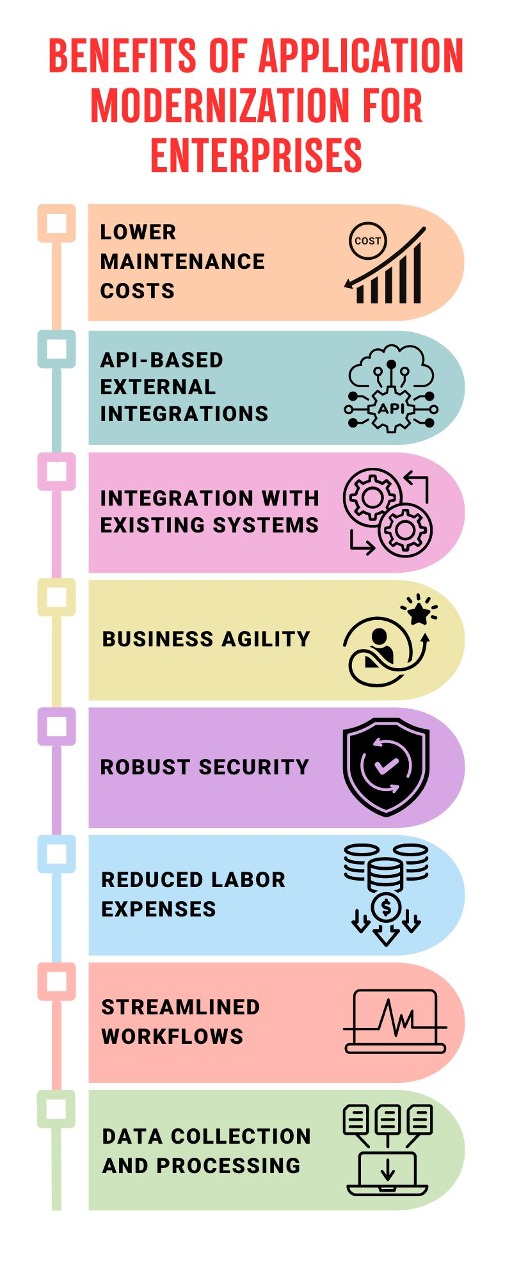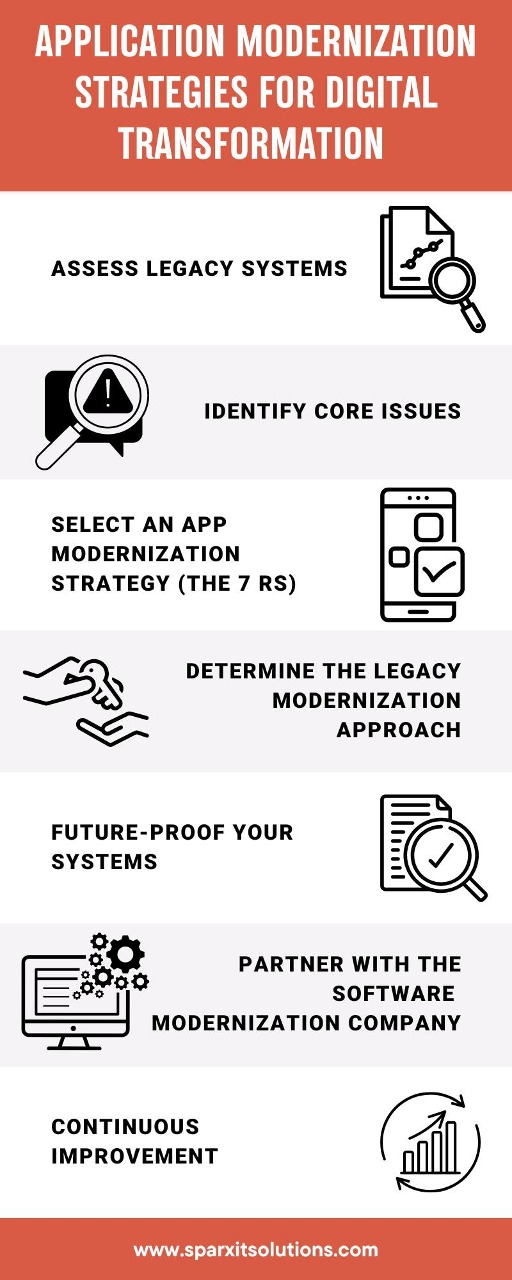Nowadays, companies are engaged in a never-ending battle against obsolescence. In fact, 91% of them are actively exploring digital initiatives. However, the software programs and processes that once drove your creativity can quickly become stumbling blocks.
Enterprises suffer from slower processes, frequent breakdowns, higher maintenance costs, and increased security vulnerabilities. These issues accumulate, restricting growth and agility in an increasingly competitive market.
Application modernization for enterprises is, therefore, essential to long-term corporate strategy. In a time of agility, cloud capabilities, and intelligent algorithms, it’s about upgrading software and reimagining how apps benefit users and companies.
Legacy software modernization is similar to putting your company on a straight route to innovation, growth, and continuous improvements. It involves moving from clunky and outdated systems to value-added, faster, secure, and scalable ones.
What is Application Modernization?
Application modernization is updating legacy applications (outdated software systems) to incorporate new programming languages, services, architecture, cloud infrastructure, and automation. It is also referred to as legacy modernization or software modernization. Examples of modernizing apps include the following:
- Refactoring a monolithic application to a microservices architecture.
- Moving an on-premise software to a public cloud.
- Distributing clusters—groups of interlinked servers across multi-cloud setups (AWS, Google Cloud, and Azure).
- Replacing sporadic, manual deployments with frequent, automated ones.
- Switching to a modern database (MongoDB or Cassandra) from a relational database (MySQL or PostgreSQL).
Why Does Your Business Need Application Modernization?
Once the mainstay of most businesses, legacy apps may become significant liabilities if their present status hinders innovation and requires much maintenance. A strong application modernization strategy can help reduce these problems. Here are some ways outdated software might hamper an organization’s digital transformation.
-
Accumulated Technical Debt
Outdated programming techniques, intricate dependencies, and ineffective architectures are common burdens that come along with older systems. This technological debt makes modification more costly, time-consuming, and prone to unexpected repercussions.
-
Limited Agility and Flexibility
Due to rigid deployment models and monolithic architectures, even slight modifications are challenging. As a result, companies can’t react swiftly to market shifts, client needs, or new opportunities.
-
Security Vulnerabilities
Dependencies are no longer actively supported, and known vulnerabilities may be present in outdated apps. This puts companies at risk of Cyberattacks that might lead to data leaks, system outages, and reputational harm.
-
Restricted Scalability
Legacy systems frequently require assistance to manage new functionality, data expansion, or increased traffic. This may result in bottlenecks, unpleasant user experiences, and missed revenue opportunities. However, scalability is achievable, albeit at a high cost.
-
Increasing Operational Costs
Maintaining outdated software can become a major resource hog. When applications age, organizations may have to deal with skyrocketing infrastructure costs and reliance on pricey legacy systems.
What are the Benefits of Application Modernization For Enterprises?

With application modernization software, businesses can implement innovative features like online payment methods, improved customer service, or captivating digital experiences.
-
Lower Maintenance Costs
Legacy apps become bloated as new features are added, and maintenance costs rise when support requests rise. Although replacing outdated systems with contemporary software would cost more upfront, doing so will save money over time.
-
Simplified API-based External Integrations
Incorporating legacy application modernization services with new technologies may require costly, specialized labor. Cloud-based, modern solutions with APIs are extremely easy to implement.
-
Seamless Integration with Existing Systems
Several modern SaaS and cloud solutions are not compatible with on-premise legacy software. Updating an application results in complete compatibility and fewer security, efficacy, and efficiency issues.
-
Improved Business Agility
Using application modernization services prevents you from being flexible and keeping up with the latest developments in your sector. A digital transformation company prioritizes agility, which modern applications make feasible.
-
Robust Security
Older operating systems, unpatched code that is no longer updated, or third-party software may all be depended upon by legacy software. This puts you at risk for security lapses that might damage your reputation and alienate clients.
-
Enhanced Productivity with Reduced Labor Expenses
Legacy modernization services will become less expensive in terms of hardware, security, and storage as they transition from an on-premise ecosystem to the cloud for business workloads.
-
Streamlined Workflows
Employees who have to deal with legacy systems must spend a lot of time and effort finding workarounds to finish their tasks. Conversely, new systems enable more productive operations.
-
Optimized Data Collection and Processing
Data silos caused by data trapped in old systems make it difficult to gather, handle, and analyze the data streams. These days’ modern applications are crafted to collect data and streamline business procedures.
Technology Solutions For Effective Software Modernization
Installing or developing a cloud-based application is now a prerequisite for modernization, but cloud computing isn’t the only aspect of it. What does a modern application look like? Integrating many essential technologies is necessary for enterprise application modernization. Let’s examine the most recent trends in Legacy app modernization.
MACH Architecture
App modernization mainly focused on microservices tools. MACH architecture has emerged as the new norm to ensure that the design exhibits the most significant degree of flexibility.
MACH is an acronym for Microservices, API-first Cloud-native, and Headless. The definitions of the terminologies are as follows.
-
Microservices
Microservices are independent services utilized for various software components and business operations that communicate with one another via APIs.
Businesses can create or select the optimal service for each component using a microservices strategy. This strategy also helps scale or switch services as needed.
-
API-First
API-first means considering API as the core of the product design rather than an add-on. This idea compels product designers to prioritize efficient communication between various components.
-
Cloud Native
All servers, databases, and applications in a cloud-native architecture operate on cloud infrastructure. Containerization ideally reduces dependencies and separates components from the more prominent architecture.
-
Headless
An application’s front end and back end are separated by a Headless architecture design, which connects them via an API. Because of this, companies may modify either the front end or the back end without impacting one another.
Applying MACH architecture to a wide range of products may facilitate a rapid launch. This allows for interchangeable components and improved scalability, resilience, and operational efficiency.
Containers
The majority of modern apps use Containers and Kubernetes. Code, libraries, and other components required to operate an application are stored in a container. Kubernetes, a platform for managing containers, aids in the formation of a single pool of computing resources.
UX Modernization
In the tech-savvy and digital era, consumers want exemplary experiences, increased personalization, and intuitive design. Examining software to determine how it may better satisfy the user’s requirements, expectations, and preferences is known as UX modernization.
Like any excellent UX design, this will require detailed research into functionality, accessibility, and visual design.
CI/CD (Continuous Integration/Continuous Deployment)
CI/CD optimizes the entire software development lifecycle pipeline. Code updates are automatically integrated into a shared repository so that developers can perform automated tests.
If the tests pass, the code is automatically pushed to the production environment. This continuous integration and deployment approach drastically shortens development cycle times, allowing teams to produce new functionality and updates more quickly.
Artificial Intelligence (AI) and Machine Learning (ML)
Businesses are introducing AI and ML into their systems in various innovative and fascinating ways, such as AI chatbots, predictive analysis, customer support, business process automation, virtual help, and many more.
Multi-Cloud Environments
Many businesses use numerous cloud migration services since different providers provide distinct capabilities. Software modernization developers may use APIs, containers, and middleware to manage workloads more quickly in a multi-cloud environment than in designing and integrating custom features into individual apps.
In-Depth Application Modernization Strategies For Digital Transformation

Once you’ve decided that modernizing your applications is your business’s best course of action, you must create an enterprise application modernization roadmap that clearly outlines the path to success.
Assess Legacy Systems
Assess your present systems comprehensively and determine which apps need modernization.
Any software that isn’t cloud-based has to be upgraded. If you’ve previously introduced new systems and existing applications don’t operate well together, pay attention to those.
Developing a comprehensive strategy to analyze your requirements and budget is crucial for many reasons, such as:
- Delivering a thorough cost-benefit evaluation
- Getting the support of the leadership
- Confirming that maintaining the status quo is not a better return on investment than modernizing apps.
Identify Core Issues
After your cost-benefit evaluation reveals that your legacy apps cannot meet the business’s current demands, it’s time to take things further.
The legacy application could fulfill the user stories without adding to the existing tech debt or interfering with other activities.
Prioritizing your app modernization plan with the help of user stories starts with identifying the issues your users and business are facing.
Select an Application Modernization Strategy
A business may approach legacy system modernization in various ways. We’ve enumerated AWS’s 7 Rs in order of complexity and resources needed to accomplish them. Starting with the simplest and working our way up to the most comprehensive and resource-intensive.
-
Retire
Retiring is a popular methodology for businesses to eliminate obsolete software and unnecessary workloads. As the name suggests, the application is simply deleted from the ecosystem without being updated, replaced, or altered in any other way.
-
Retain
Retaining a legacy application or system involves encapsulating it and creating an API wrapper to interface with modern systems. This enterprise application modernization process is usually less expensive upfront and can be effective if you’re going for a hybrid migration.
-
Relocate
Relocating is a new tactic that involves migrating workloads without changing the source code or investing in new hardware. For instance, a business may move from using an on-premises Kubernetes platform to one hosted in the cloud, like Amazon Elastic Kubernetes Service (EKS).
-
Rehost
Lift and shift, another name for rehosting, refers to redeploying workloads in the cloud using Infrastructure-as-a-Service (IaaS) without modifying the underlying infrastructure.
-
Repurchase
Repurchasing is the process of replacing internally operated systems with external ones that are monitored and maintained by a third-party service. It’s an excellent method for moving to a use-based model and retiring outdated systems.
-
Replatform
Replatforming is the process of migrating apps to the cloud while adding components for platform optimization to enable cloud-native operations. It may be an affordable method of saving money and taking advantage of some native cloud applications.
-
Refactor
Refactoring is regarded as the most challenging and time-consuming method of modernizing applications. It requires a more comprehensive re-architecting of all workloads and is more expensive than the abovementioned methods. However, with a fully cloud-based, serverless, API-first methodology, it offers the highest level of future-proofing, scalability, and flexibility.
Determine the Legacy Modernization Approach
Your application modernization strategy selection will depend on your understanding of the user experience for internal and external users (workers and partners).
User stories are essential for determining legacy application modernization since they highlight the problems with existing apps and what can still be saved.
The most popular methods for modernizing legacy applications are replatforming and refactoring—the ideal balance of convenience and return.
Future-Proof Your Systems
Nowadays, 90% of businesses are held back by outdated technology, and the last thing they want to do is develop an app that adds to their technical debt. Therefore, depending on your budget, select the application modernization framework with the least “lock-in.”
Ask questions like how long an application modernization process will last, if replatforming or restructuring is the better long-term strategy or not.
Partner with the Right Software Modernization Company
Only some businesses update their apps using internal resources. Most companies want to hire a legacy software modernization company that can finish the job without deviating from their responsibilities.
Dependable legacy application modernization services can provide technical know-how and connect you with experienced developers who are knowledgeable about the newest cloud, mobile, and web technologies and application modernization tools.
Consider a digital transformation agency with a proven track record of utilizing agile development to offer end-to-end solutions. Ensure they can also accommodate the newest digital products and consumer experiences.
Optimize for Continuous Improvement
Iterative feedback is crucial to every successful product development process, and application modernization for enterprises is no exception.
Agile development concepts are intended to facilitate quick development supported by transparency, ongoing feedback and enhancement, and flexibility.
DevOps is also crucial because it facilitates the alignment of the development and operations teams. It enables effective deployments and coordinated strategies that lower mistakes and improve teamwork.
Application Modernization Business Case for Sustainable Growth
Tech enthusiasts occasionally make the error of thinking that app modernization’s advantages are self-evident. The harsh reality is that you’ll need support from non-technical leaders before you can proceed.
Like any other business need, the modernization of apps must have a strong business case that outlines the company’s advantages and return on investment.
Your business case should include:
- The issues you are attempting to resolve and how they affect the company.
- The cost of application modernization for enterprises.
- An exhaustive evaluation of legacy software modernization services and their benefits.
Additionally, the business case will assist you in persuading employees of all ranks about the benefits of cloud application modernization. If people know why you’re doing things, they’ll adopt and use the new technology.
Legacy Application Modernization Provides Optimal Results
Legacy applications must be updated or replaced as part of software modernization. These apps no longer improve (or support) the user experience and are often not cloud-based.
Application modernization solutions ensure that your technology infrastructure is aligned with current business needs, delivering long-term value and improved performance.
Key benefits of legacy application modernization:
- Enhanced system performance
- Improved security and compliance
- Reduced maintenance costs
- Greater scalability
- Seamless integration with new technologies
Enterprise Application Modernization Helps in Driving Efficiency
Enterprise application modernization is a big task that needs meticulous planning and vision. It also requires multi-level buy-in and a detailed evaluation of the time and resources needed to complete the task correctly.
The following guidelines help your attempts at enterprise app modernization.
- Make a comprehensive business case.
- Describe the advantages to the entire company.
- If the knowledge that your staff lacks, hire an outsourcing partner.
- To gauge success, determine the key performance indicators (KPIs).
- Conduct a comprehensive risk assessment.
Ensure that every new app functions well with the legacy applications you plan to replace during the process.
How Cloud-Based Application Modernization Offers Competitive Advantage?
Cloud-native application monetization guarantees that they utilize all the benefits cloud computing offers.
Even though cloud compatibility is the main emphasis of software product development services, businesses may keep legacy software by developing an API that communicates with cloud-native apps.
What distinguishes cloud-native apps? These applications:
- Adopt a microservices architectural methodology.
- Employ headless architectures to enable several front-ends to run on a single back-end.
- Consider an API-first approach.
- They are very scalable and agile.
Establishing a cloud-native ecosystem is the most adaptable and potent choice. We call this refactoring. When done correctly, this method of digital transformation through application modernization is costly but will ensure that your company’s technology is ready for the future.
How Can SparxIT Help You With Legacy Software Modernization?
Application modernization for enterprises offers numerous business advantages, such as higher developer productivity, lower infrastructure costs, more frequent releases, and accelerated time to market.
Determining if your application needs to be modernized and the best course of action requires understanding its current status. SparxIT shines as a trusted digital consulting company for business owners, helping them understand their current architecture and the opportunities for improvement.
Our ability to use data and software to create richer digital experiences gives it a competitive edge. Whether building a brand-new application or modernizing an existing one, SparxIT makes it remarkably simple to move from a concept to an application that achieves outstanding results.

Partner with Experts
Frequently Asked Questions
How do application modernization services improve business operations?






Modernizing applications better equips businesses to respond swiftly to market shifts and future expansion because it increases efficiency, lowers operating costs, increases scalability, and enhances security.
What challenges are faced during legacy app modernization?










Typical obstacles include complex data migrations, system incompatibilities, possible outages, and coordinating modernization efforts without interfering with current business operations.
How much does enterprise application modernization cost?










Enterprise application modernization can cost between $40,000 and $1.5 million. Costs are influenced by the project’s size, complexity, and particular business needs. Precise budgeting requires a thorough evaluation.
How long does it take to modernize enterprise applications?










Modernizing an enterprise application can take anywhere from one month to over a year. The project’s duration will determine its size and scope, although it usually spans several months to more than a year.




